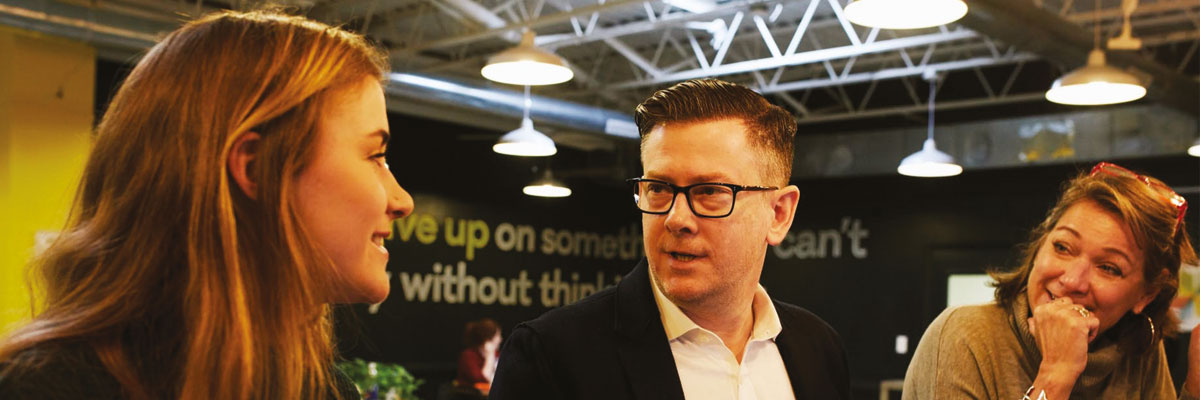Foreword
Over the past decade, technology has promised to make our jobs better.
We’ve been repeatedly told that communication and collaboration tools will make us more productive, engaged and happy in our work. But despite huge leaps forward in technology adoption and maturity, the dial has barely moved on employee satisfaction. And few organisations are seeing efficiency gains. Despite a huge investment in tools, productivity per employee in the UK has been stagnant since 2007, with economists calling this a ‘crisis of productivity’. Nexer’s research takes a deep dive into user experience at work and finds it wanting, with clear impacts on the bottom line.
This report highlights a widespread failure to deliver on technology’s promise of productivity. Surveying hundreds of workers, it finds a huge proportion of employees are frustrated by the tools they use at work, and the processes that underpin them. Workers are given a proliferation of platforms with overlapping functionality and poor user experience, which leaves them overwhelmed, distracted and frustrated.
Working life was already changing at a rapid pace when along came COVID-19 and remote working accelerated by ten years practically overnight. Suddenly, the quality and ease of use of technology is more important than ever. The tools we use aren’t just critical to delivery, they’re also the primary way we experience our employer’s brand, connect with our colleagues, and sustain a sense of belonging.
The study found the average employee surveyed uses four digital tools regularly, with some using nine or more every day. But these don’t necessarily lead to increased efficiency or output. In fact, a significant minority of employees (40%) feel let down by the digital tools they’re given at work. And organisations with fewer tools also appear to send more emails, suggesting more isn’t necessarily better when it comes to workplace tech. But it’s not all about the quality of tools. The report’s central finding is that there’s an excessive focus on introducing new tools, rather than rethinking the processes behind them or the overall digital employee experience.
The report finds that 86% of workers believe company processes need to be improved. Just four in 10 workers think meetings are fully effective. Nexer's report urges businesses to take a strategic, user-centred approach to workplace technology, just as they do for public facing services.
Digital work tools should be designed with employees, not imposed on them, seeking to understand how things can be done more effectively rather than moving existing analogue processes and practices on to digital tools.
It’s only when businesses challenge their ways of working with a user-centric approach to technology that the promise of productivity, engagement and work-life balance will be delivered.
The report recommends firms conduct regular reviews of their digital workplace, to ensure the overall experience for employees is consistent, coherent and helps rather than hinders productivity. As businesses shift from COVID-19 recovery mode to look at how they can work remotely for the long term, this advice has never been more urgent.
Sharon O’Dea
Sharon O’Dea is an award-winning digital strategist with a track record advising complex organisations on communication, collaboration and digital workplace technologies.

Our Research
OUR WORKPLACES ARE CHANGING
Disruptive innovation and the increased expectation for ‘on demand’ services have infiltrated our working lives, with the technology-enabled promise of flexible working and a happier, more empowered and more productive workforce. We are also increasingly conscious of the impact commuting has on our daily lives, transport infrastructure and the environment, where efficient and effective meetings could be game changing.
Productivity is an important measure for most businesses and for the UK economy as a whole, but of course, nobody expects every UK worker to be 100% productive for every second of the day. Breakout spaces and coffee breaks are, after all, hailed as heroes of creative thinking. And is it fair to treat output as the only measure of production? Culture, job satisfaction, flexibility and environment all play a part in building and nurturing effective, efficient teams.
But time is money, so implementing time-saving processes and systems that can help projects and teamwork run more seamlessly can drive serious benefits to a company’s bottom line. It’s about making marginal changes throughout an organisation that expediate as many processes, as much as possible. More importantly, it’s time we consider productivity alongside the actual user experience of being at work.



marginal Changes
Digital technology has been hugely impactful in this respect. Rather than sending lengthy letters or faxing through information, for example, workers can drop colleagues a line through email, via a messaging channel or via Slack or Microsoft Teams – all at touch of a button, on the go and in a collaborative way. Our working lives have become almost entirely supported by innovative digital tools and platforms – something that has completely changed the face of UK business over the past 20 years.
However, at the same time, many of the tools that currently exist to increase productivity and improve the user experience are actually having the opposite effect. They are stifling it. Despite being designed to save time, the myriad of different tools can leave workers feeling at best distracted – at worst overwhelmed. People often don’t know which tool to use for which purpose.
Poor usability also doesn’t help, as people feel frustrated when attempting what should be simple tasks. They create offline workarounds or nominate super users with specialist system knowledge. Organisations also use training as a sticking plaster for poor systems, patching bad user experience with expensive comms and education.
Our Report
This report has been put together to look into the productivity and satisfaction levels of UK businesses, by conducting a deep-dive into the user experience at work. We surveyed 500 employees from medium-large businesses in a range of sectors about their current processes.
Latest figures from the Department for Business, Energy & Industrial Strategy show that there are currently 43,000 medium-large sized businesses in the UK. These make up 53% of all employment, with 14,142,000 people employed at these enterprises.
How many emails do these employees send per day? How many phone calls do they have to field? How many internal meetings do they have to attend? Are any of these things conducive to a smooth workflow...or do they simply serve to distract people from their daily tasks and make them more inefficient and frustrated as a result?
Additionally, does part of the problem lie in implementing these tools and systems across large organisations? Do they take in consideration the needs of every single worker? Are changes being properly communicated across the business, or do workers feel alienated by new technology? Crucially, do office workers believe that the systems they are asked to use on a daily basis make a real difference to their working lives? Are tools and processes designed around user needs and do they offer a supportive, inclusive experience?
Key Findings
Data and IT workers waste the most time on complex digital tools
Six in 10 workers miss important work emails or messages
Only four in 10 workers think meetings are fully effective
86% of UK workers call out for better company processes
Two in five workers feel let down by digital tools
Section 1
THE STATE OF PLAY: HOW DIGITAL ARE UK WORKPLACES?
HOW MANY DIGITAL TOOLS DO WORKERS USE EVERY DAY?
In recent years the workplace has been revolutionised by digital communication tools, including instant messaging, video conferencing and project management applications, such as Slack, Microsoft Teams, Skype and Asana.
On average, UK workers are using four digital tools in their daily lives. However, in 6% of cases, this increases to more than nine.
That equates to almost 850,000 workers having to juggle a growing number of tools that are meant to make their lives easier. But, as we will see, there is not always a positive correlation between the number of tools used and the output of that worker.
How many digital work tools do you use day-to-day?
| No. of tools | % of people |
|---|---|
| 0-1 | 13% |
| 2-3 | 34% |
| 4-5 | 34% |
| 6-8 | 12% |
| 9+ | 6% |
| Mean | 4 |
The data also shows that workers in businesses with 500-2,000 employees are most likely to use a higher-than-average number of digital tools in their day-to-day lives.

HOW MANY EMAILS DO WORKERS SEND EVERY DAY?
How many emails do you send, on average, on a daily basis?
| No. of emails | % of people |
|---|---|
| 0-10 | 13% |
| 11-23 | 32% |
| 26-50 | 31% |
| 51-75 | 10% |
| 76-100 | 2% |
| 100+ | 4% |
| Mean | 31 |
The employees we surveyed are sending on average 31 emails every day – but for 4% (or 565,680) workers, it is over 100. It may be expected that those businesses with a higher- than-average number of digital tools send fewer emails. But this does not seem to be the case.
In fact, we found that organisations with 500 - 2,000 employees send around 28% more emails every day than those who use fewer-than- average digital tools. Firstly, this suggests that the tools are impractical. It also suggests that these tools may be conflicting and could lead to workers doubling up on the same tasks.
Email, for example, can be used as a way to communicate with colleagues. But what happens when different teams across the business – perhaps individually – start using messaging apps or digital collaboration spaces to post and share information? Email doesn’t suddenly become a legacy channel; new ones are simply added on top. Instead of just checking emails, therefore, everyone has to stay on top of numerous channels at once – a potentially time-consuming task. Where do you go for what and how is that understood by new and existing employees within teams?
HOW MANY PHONE CALLS DO WORKERS MAKE AND RECEIVE EVERY DAY?
How many phone calls do you make and/ or receive, on average, on a daily basis?
| No. of phone calls | % of people |
|---|---|
| 2-3 | 16.8% |
| 4-5 | 22% |
| 6-8 | 18% |
| 9-10 | 11.6% |
| 11+ | 22.8% |
| Mean | 6 |
A fifth of UK workers make and/or receive more than 11 calls per day – something that may be a huge distraction to their everyday tasks. Of course, these may be quick calls to expediate a written conversation – but again we see that communication is potentially being replicated.
A report by telecommunications regulator Ofcom revealed that in 2017 the total volume of phone calls declined by 1.7 percent, the first time ever the number of calls on traditional mobile networks fell in the UK perhaps signalling a shift in methods of communication.
HOW MANY INTERNAL MEETINGS DO PEOPLE ATTEND EVERY DAY?
How many internal meetings do you have, on average, on a daily basis?
| No. of meetings | % of people |
|---|---|
| 0-1 | 43% |
| 2-3 | 42% |
| 4-5 | 11% |
| 6+ | 4% |
| Mean | 2 |
Lastly, our survey respondents reported taking part in two internal meetings, on average, every day, with one in 10 attending four to five meetings every day. Whilst meetings are undoubtedly necessary, in many cases they can keep workers from actioning their own tasks. Indeed, a recent study, by Harvard Business Review, found that 71% of senior managers said that meetings are unproductive and inefficient, with a further 62% highlighting that they come at the expense of deep thinking.
Overall, it seems there is a relatively mixed picture when it comes to how employees carry out their daily tasks. Although the data does suggest a number of UK workers are increasing the overall frequency of communication between colleagues, at the current level of implementation of new digital tools.
Let’s look more closely at what workers they see as the biggest challenges of digital working.

Section 2
WHAT ARE THE CHALLENGES OF DIGITAL WORKING?
DISTRACTION
Have you ever missed an important work email or message?
| Yes, because I get too many / I struggle to keep on top of them all | 32% |
| Yes, because I use so many different systems and tools | 16% |
| Yes, because it automatically went into a junk folder | 13% |
| Yes, because the tools I use don’t alert me to them properly | 9% |
| No | 29% |
Six in 10 of the workers we polled have missed an important work email or message. That’s a worryingly large amount, equating to more than 8.6 million people across the UK.
For many of these people, the message was missed because they find it difficult to keep on top of their inbox. However, for others, it’s down to friction in the tools they use and how many channels they have to manage at one time.
Not only can lost email conversations cost in terms of miscommunication (and the frustration this causes), they also decrease productivity. Chasing a colleague or business contact on an email request takes time and delays action being taken. Ironically, therefore, the tools that are meant to drive efficiency are having the opposite effect.
This is particularly a problem in the hospitality sector, where 33% of people say they have missed an important message because of the number of different tools they have to switch between.
On a daily basis, how much time do you lose on products, programmes or tools that you struggle to use, that don’t work properly or that you don’t understand?
| Time lost | % of people |
|---|---|
| 0-10 mins | 29% |
| 10-30 mins | 38.4% |
| 30 mins-1 hour | 25.6% |
| 1-2 hours | 7.2% |
| 2+ hours | 0.4% |
| Mean | 28 |
The average worker in medium-large businesses loses 28 minutes every day on these processes. Almost two in five lose up to 30 minutes every day due to difficult-to-use, inefficient or difficult-to-understand digital tools – with another quarter losing up to an hour.
For a full-time member of staff, this works out at 560 minutes (9.3 hours) per month or 112 hours per year.
There is clear variation across sectors when it comes to the amount of time wasted on difficult-to-use tools:
When considering that the average starting salary for a data scientist is £30,000, even small businesses in this sector, with 20 data scientist employees, could be wasting tens of thousands every year on wasted, salaried time.

What does this look like in practice?
A data scientist on a starting salary of £30,000 is wasting 16.3 hours per month or 195.6 hours per year.
Salary = £30,000
30,000 (£) ÷ (252×7.5)
= £15.80 per hour
15.80 (£) × 195.6 (hours)
= £3,104 lost every year per employee
3,104 (£) × 20 (employees)
= £62,080 in salary wasted every year
WHAT ARE THE BIGGEST FRUSTRATIONS WHEN IT COMES TO DIGITAL WORKING?
As we have discussed, digital working is far from seamless across the UK’s business landscape. And workers have strong feelings when it comes to this issue; many of which revolve around the burden that digital tools can have on productivity levels.
Respondents also highlighted the impact that keeping on top of digital platforms can have on their mental health or wellbeing, with their constant pop-ups, notifications, and unread messages.
Almost a third (32%) of people we surveyed highlighted that – in many cases – it’s simply easier to have a face-to-face conversation than to communicate via digital tools.
While a quarter (25%) state that having numerous digital tools to use can take time to get used to, which may have an impact on productivity.
| Frustrations | % of people |
|---|---|
| It’s quicker to have a face to face conversation | 32% |
| The tools crash / don’t work properly | 30% |
| You need to be trained up on them / get used to them which takes time | 25% |
| Tools require a good internet connection | 24% |
| The tools don’t integrate with each other | 23% |
| Information can get lost in “chat” that isn’t related to work | 22% |
| Information is spread too widely across different tools | 20% |
| It makes it harder to switch off | 18% |
| It can cause stress/anxiety | 18% |
| Tools can be misused (i.e. messages being sent during evenings and weekends) | 17% |
| It’s difficult to search for the information you need | 17% |
| The training isn’t good enough | 16% |
| Tools can distract me from my day-to-day tasks | 16% |
| It makes “version control” difficult | 14% |
| It makes collaboration more difficult | 12% |
Perhaps most importantly, UK workers are getting far too easily distracted by communication tools.
Every day, the average person in our survey gets pulled away from their main tasks six times. For almost 850,000 workers, this increases to 13 times.

How many times, on average, are you distracted from your main task during the day by emails, phone calls or internal meetings?
A data scientist on a starting salary of £30,000 is wasting 16.3 hours per month or 195.6 hours per year.
| No. of times distracted | % of people |
|---|---|
| 1-3 | 38% |
| 4-8 | 38% |
| 9-12 | 17% |
| 13+ | 6% |
| Mean | 6 |
Do you think that your company’s processes could be improved to save time?
Although “digital transformation” is taking place across all business sectors, our survey suggests that there is still much to learn when it comes to getting the basics right. A huge 86% of people think that their organisation’s processes could be improved in some way in order to save time and make them more productive. At their heart, digital tools are supposed to boost efficiency and make life easier. But technology is ineffective unless staff are bought-in and see that it makes a genuine improvement to their working life.
Do you think that the business tools you use at work help to make you more productive?
| Yes, they save me time and mean I can carry out tasks more efficiently | 32% |
| No, they make me less productive and efficient | 20% |
Concerningly, a fifth of UK workers say that the tools they use in the office make them less productive, equating to as many as 6 million people across the UK. Not only is this a huge problem for business profitability, it could be a cause of stress, anxiety and frustration in the workplace as workers struggle to get their jobs done in a timely way.
The state of the UK’s mental health has been discussed at length in many studies and only appears to be getting worse. Indeed, a report by HSE suggests that there were 15.4 million working days lost to work-related stress in 2017/18 alone. Organisations must therefore find a solution to the issue – quickly – and better, more effective digital tools could provide part of the strategy.
Section 3
MEETINGS AND COLLEAGUE COMMUNICATIONS
PRODUCTIVITY OF MEETINGS
Do you find meetings (and the technology used to schedule / hold them) effective?
| % of people | no of people | |
|---|---|---|
| Yes, they are effective | 41% | 204 |
| Yes, but they could be better | 46% | 232 |
| No | 13% | 64 |
Only 41% of respondents said they find meetings fully productive, with a further 46% saying that they could be improved in some way.
A recent study by Crowne Plaza Hotel & Resorts, found that the average employee wastes nearly 13 working days every year in ‘unproductive’ meetings – so the frustrations from workers are perhaps unsurprising.
Clearly, UK businesses must find ways to make meetings work better. Solutions for this could include cutting them shorter, holding “stand- up” meetings which are inherently more to-the-point or ensuring that the technology used to support them is more robust and reliable. Tools should help to better manage tasks and meetings, not complicate them.
HOW WELL DO TEAMS COMMUNICATE INTERNALLY?
Do you think internal communication between colleagues could be improved?
| % of people | no of people | |
|---|---|---|
| Yes, it needs to be overhauled completely | 33.6% | 168 |
| Yes, improvements could be made | 58.4% | 292 |
| No | 8% | 40 |
Internal communications are a key factor in the success of any organisation – but perhaps no more so than in medium to large-sized enterprises. It is a function which ensures that everyone in the business is working towards the same goals, whilst also driving engagement. However, a recent report by Gatehouse, an internal communications agency, found that technology is the top barrier to internal communications, something that was reflected in our survey.
A third of respondents said that their organisation’s internal communications should be overhauled completely – a huge amount. It’s also a worrying one, given that organisations are increasingly becoming globalised and remote working is on the rise. It’s therefore vital that this is improved upon if companies are to maintain a fully engaged workforce in the future.

REMOTE WORKING: THE STATE OF PLAY
Does your company have a flexible and/or mobile working policy?
| % of people | no of people | |
|---|---|---|
| Yes | 69% | 346 |
| No | 31% | 154 |
Would you like a flexible and/ or mobile working policy?
| % of people | no of people | |
|---|---|---|
| Yes | 66% | 102 |
| No | 33% | 52 |
Remote working is becoming the “new normal” for UK workers, according to new research by global workplace technology company, Condeco – but we found that almost a third (31%) of employees are still unable to take advantage of working remotely. Of course, this may be due to the type of industry in which they operate, but it’s clear that – regardless of sector – there is huge demand amongst workers for this type of flexible policy. Amongst those workers who don’t already have remote or flexible working, two-thirds say that they would like to have it.
IS REMOTE WORKING PRODUCTIVE?
How easy is it to communicate and collaborate with colleagues when they are out of the office?
| % of people | no of people | |
|---|---|---|
| Very easy | 30.1% | 104 |
| Easy | 48% | 166 |
| Neither easy nor difficult | 13.9% | 48 |
| Difficult | 7.5% | 26 |
| Very difficult | 0.6% | 2 |
However, as flexible working becomes more commonplace, it’s imperative that communications platforms that enable this to work seamlessly are improved across the board. 8% of workers find it either difficult or very difficult to communicate with colleagues when they are working out of the office. That’s almost 2.5 million workers.

Section 4
Digital Transformation
HOW COMMON IS DIGITAL TRANSFORMATION?
Have you ever been asked to implement or incorporate a new technology tool into your work? For example, a new messaging platform, operating system or intranet?
| % of people | no of people | |
|---|---|---|
| Yes | 60% | 302 |
| No | 40% | 198 |
According to research, the UK is leading the way in digital transformation. However, this does not appear to tally with our findings that four in 10 survey respondents have never been asked to implement or incorporate a new technology tool into their work. This suggests that UK businesses are not as far ahead of others in future-proofing their operations as first thought, potentially leaving themselves vulnerable to lower levels of productivity.
DOES DIGITAL TRANSFORMATION DRIVE PRODUCTIVITY?
Do you feel it made your day-to- day working life better / more productive / more efficient?
| % of people | no of people | |
|---|---|---|
| Yes | 81% | 244 |
| No | 19% | 58 |
Moreover, concerningly, of those who have implemented a new technology, a fifth say that it did little or nothing to improve the quality of their work. Clearly, some businesses are recognising a need to “digitise” their workforce but are being let down by the systems they choose or are sold. This could lead to a reticence to further innovate in the future.

WHO IS DIGITAL TRANSFORMATION DRIVEN BY?
Who was the change / implementation driven by?
| % of people | no of people | |
|---|---|---|
| The HR team | 15.2% | 46 |
| The IT team | 48.3% | 146 |
| The Senior Leadership team | 35.8% | 108 |
The team driving the digital transformation depends on what the transformation entails (traditional IT roll-outs versus digitising team or departmental processes) and the culture of the organisation, as is suggested by the mixed responses to this question.
The more important factors in the success of the transformation are communications, buy-in, representation and involvement from users.
DO ALL WORKERS FEEL PART OF DIGITAL TRANSFORMATION?
Did you feel part of the change/ implementation process?
| % of people | no of people | |
|---|---|---|
| Yes, everything was communicated fully | 53.4% | 164 |
| Yes, but it could have been communicated better | 48% | 166 |
| Neither easy nor difficult | 35.1% | 106 |
| No, I felt left out of the process | 10.6% | 32 |
One in 10 workers felt “left out” of the change process, with another 35% saying that communication was not a complete success. This stage is crucial to ensure that any technology implementation goes smoothly. Without the backing of staff, it will simply not work.
Do you have or are you aware of any colleagues who have specific technology access needs?
| % of people | no of people | |
|---|---|---|
| Yes | 49.2% | 246 |
| Yes | 50.8% | 254 |
Section 5
Conclusions
CONCLUSION
The UK’s business landscape is changing – driven largely by the digital transformation taking place across our entire society.
As such, the UK’s workforce is simultaneously expected to change to ensure that businesses can remain productive and commercially viable, and their employees happy and motivated.
However, there seems to be a disconnect between organisations recognising the need for change and actually providing employees with the support that can genuinely improve their performance or experience. With 1 in 5 people being digitally excluded in the UK, does digital transformation and a proliferation of tools further exclude some people from the world of work, or make it hard for them to take on new roles, a problem exacerbated by poorly designed or badly implemented platforms?
A huge range of digital tools exist on the market that can – in theory, at least – create a more satisfied and productive workforce. But, as our research shows, both the tools themselves and the methods of implementing them across businesses are not flawless.
It’s therefore important that we evaluate the role of technology in our working lives, and question how it can be harnessed most effectively to drive not only improved productivity but also better work-life balance, mental health and job satisfaction before it is implemented across whole companies.
ADVICE AND BEST PRACTICE
Businesses should always challenge the way they are working to help employees get more out of every day. And this also applies to the digital tools they choose to adopt and use. Businesses should undertake regular reviews of their digital workplace to ensure it provides an environment that helps individuals, teams and the company as a whole to work happily, healthily and productively.
When it comes to digital workplace tools, more is not always better. Too many tools can adversely affect productivity levels, especially if employees do not know how to use them properly or struggle to manage and access them easily. There may also be tools that are redundant because they don’t serve a clear purpose, provide demonstrable value, or are too complicated to use.
When deciding to introduce digital technologies into the workplace, businesses should take a user-centred approach. User research and usability testing is common for public facing websites and apps but it’s time to use these methods in the workplace. From co-design with employees, to ergonomic and ethnographic studies, we really should spend more time in designing tools for people to work with in their everyday working lives. It’s important to define the purpose, goals and benefits of the tools that make up the digital workplace to ensure that all stakeholders are made aware of how best to use the right tools for the job.
Nexer Digital conducts a lot of user experience research, design and testing around corporate tools. We are interested in designing products and processes around real employee needs and contexts. The work we do helps to align technology, people and business processes to improve employee engagement, reduce frustration and enhance productivity.
Nexer Digital also works with the Microsoft 365 platform, which in many organisations is often poorly implemented. To overcome this Nexer Digital can help to map and analyse the current digital landscape and clarify to users when and how they should use different tools. Implementation is more successful when the benefits are properly demonstrated and explained. Therefore, we don’t only concentrate on the technical roll-out but help organisations also with user research, behaviour change, and communication.

Get in touch
If you would like to work with our team on your project, email us at hello@nexerdigital.com or call our Macclesfield office on +44 (0)1625 725446






